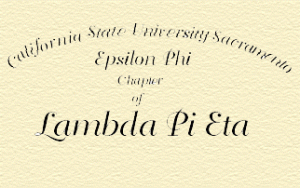I’ve been fascinated with the concept of identity for most of my life.
When I was in my early teenage years, I saved quizzes from magazines that would ask the reader “What’s Your Decorating Style” or “Are You A Romantic.”
I’ve been into astrology since those years too, and studied the characteristics of my astrological sign trying to figure out the validity of the traits.
 In 2006, one of my communication studies students asked me to make a presentation to the undergraduate honor society for which she was an officer.
In 2006, one of my communication studies students asked me to make a presentation to the undergraduate honor society for which she was an officer.
When Johanna-Joy asked what job title to call me for that night’s event publicity, I really didn’t know.
I taught classes on campus, but was not full time faculty.
I organized special events and wrote for the offices of university advancement, but was not full time staff.
The front of my campus identification read graduate student, but I was eligible for faculty parking. Sometimes the sticker on the back of my card was for a staff or faculty bus rider.
I was issued a retirement plan as a campus employee, but was not eligible for healthcare or 401K benefits.
And although I was active with broadcast news organizations, spent a lot of time with news colleagues, and had worked more than 10 years in a newsroom, I hadn’t drawn a TV station paycheck for three months.
So her question concerned me because I felt like I had no clear identity. I didn’t have a simple career with only one title. I was no “Doctor,” “Reporter,” “Administrative Assistant,” “Firefighter.”
Who was I?
I ended up giving a presentation titled “The Myth of the Real World: Searching for Identity During and After College.” I debunked myths and perceptions of real world versus college world.
Questions of identity stay with me. In fact, as I embark on a new job adventure and have started this website, I continue to ponder “who am I?”
I pulled out my notes from that 2006 communication studies undergraduate honor society event.
I should have paid more attention to my own speech. Here are the first five points I made to the students:
1. University and reality—There is no one or the other. There’s an overlap of one life to the next. Just like in everything. There is no place A and place B. The real name of the place should be AB or BA.
2. Plan and random—The path doesn’t look like: college, full-time job, marriage, baby, retire at 65. Sometimes there’s a baby first, retirement at 75, and no marriage. There’s no reason you need to justify to yourself or anyone else any deviation you make from this so-called path.
3. Moving and staying home— Some assume they have to stay in town rather than explore the world. “But my family and friends are here…” Be flexible.
4. Important and unimportant— There are no little jobs, only little people. Treat every moment as an opportunity to excel. I worked two more years at Sizzler after graduation. Was I content merely to fill the salad bar lettuce bowl? No, I started a store newsletter, then one for the region that was supported by the corporation itself. I was not full-time in university advancement. But when I was asked to hold the microphone for audience members at the president’s Town Hall meeting, I did it with style and professionalism.
5. Permanent and temporary— The first full-time job will not be your last one. Know this when job hunting. When I graduated with my bachelor’s degree, I freaked out that I wasn’t working a full-time job. One low-paying or part time gig will not be your last position. Don’t think “All that school and this is it?”  Because it is not. Nothing is permanent. Not even a marriage.
Because it is not. Nothing is permanent. Not even a marriage.
If we all learned to embrace the gray areas and uncertainty, wouldn’t our relationships and lives be all the better for the knowledge we do not have to stay on one path?
